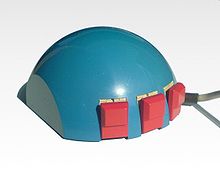Bill English, builder of Engelbart's original mouse,[11] invented the ball mouse in 1972 while working for Xerox PARC.[12]
The ball-mouse replaced the external wheels with a single ball that could rotate in any direction. It came as part of the hardware package of the Xerox Alto computer. Perpendicular chopper wheels housed inside the mouse's body chopped beams of light on the way to light sensors, thus detecting in their turn the motion of the ball. This variant of the mouse resembled an inverted trackball and became the predominant form used with personal computers throughout the 1980s and 1990s. The Xerox PARC group also settled on the modern technique of using both hands to type on a full-size keyboard and grabbing the mouse when required.
Mechanical mouse, shown with the top cover removed
The ball mouse has two freely rotating rollers. They are located 90 degrees apart. One roller detects the forward–backward motion of the mouse and other the left–right motion. Opposite the two rollers is a third one (white, in the photo, at 45 degrees) that is spring-loaded to push the ball against the other two rollers. Each roller is on the same shaft as an encoder wheel that has slotted edges; the slots interrupt infrared light beams to generate electrical pulses that represent wheel movement.
Each wheel's disc, however, has a pair of light beams, located so that a given beam becomes interrupted, or again starts to pass light freely, when the other beam of the pair is about halfway between changes. Simple logic circuits interpret the relative timing to indicate which direction the wheel is rotating. (This scheme is sometimes called "quadrature encoding" or some similar term by technical people.) The mouse sends these signals to the computer system via a data-formatting IC and the mouse cable. The driver software in the system converts the signals into motion of the mouse cursor along X and Y axes on the screen.
The ball is mostly steel, with a precision spherical rubber surface. The weight of the ball, given an appropriate working surface under the mouse, provides a reliable grip so the mouse's movement is transmitted accurately.
Ball mice and wheel mice were manufactured for Xerox by Jack Hawley, doing business as The Mouse House in Berkeley, California, starting in 1975.[13][14]
Based on another invention by Jack Hawley, proprietor of the Mouse House, Honeywell produced another type of mechanical mouse.[15][16]Instead of a ball, it had two wheels rotating at off axes. Keytronic later produced a similar product.[17]
Modern computer mice took form at the École polytechnique fédérale de Lausanne (EPFL) under the inspiration of Professor Jean-Daniel Nicoud and at the hands of engineer and watchmaker André Guignard.[18] This new design incorporated a single hard rubber mouseball and three buttons, and remained a common design until the mainstream adoption of the scroll-wheel mouse during the 1990s.[19] In 1985, René Sommer added a microprocessor to Nicoud's and Guignard's design.[20] Through this innovation, Sommer is credited with inventing a significant component of the mouse, which made it more "intelligent;"[20] though optical mice from Mouse Systems had incorporated microprocessors by 1984.[21]
Another type of mechanical mouse, the "analog mouse" (now generally regarded as obsolete), uses potentiometers rather than encoder wheels, and is typically designed to be plug-compatible with an analog joystick. The "Color Mouse", originally marketed by Radio Shack for their Color Computer (but also usable on MS-DOS machines equipped with analog joystick ports, provided the software accepted joystick input) was the best-known example.


